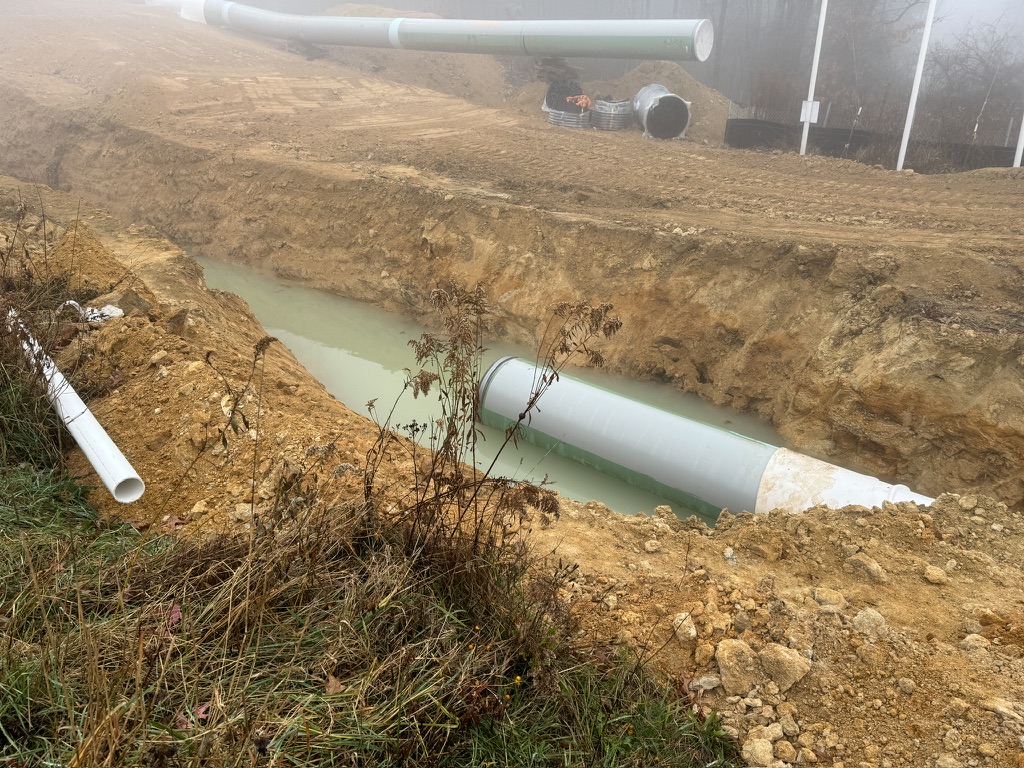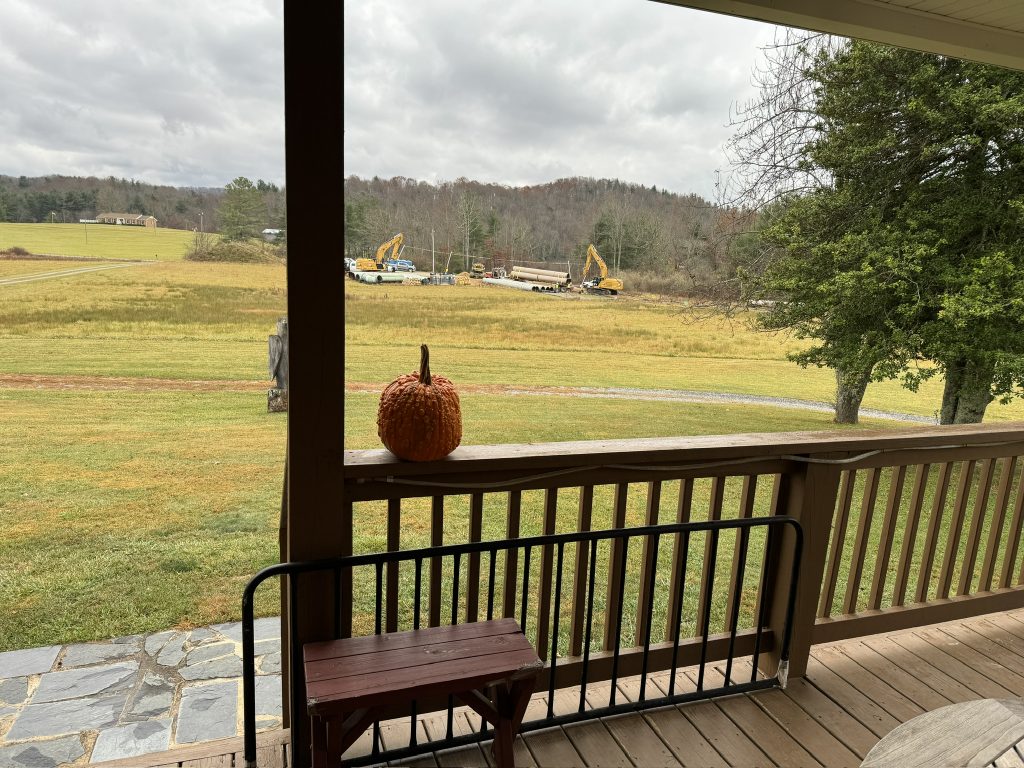‘Invaded, Disregarded and Dismissed’

From left, Theresa “Red” Terry, Robin Austin, Roberta Bondurant and Kathy Chandler walk through the woods to get a better view of pipeline construction on Terry family land. Photo by Dan Radmacher
By Dan Radmacher
The work starts early, before dawn, and it’s noisy: the revving of heavy equipment engines, back-up beepers, the rattle of treads, the click-clack of wheels over roads made of timber mats to prevent equipment from sinking into bog.
For some residents of Bent Mountain in Virginia, the noise of the construction of Mountain Valley Pipeline is in the distance. For others, it’s very near — right in their front yards in some cases.
And when it starts — often seven days a week — phones across the highlands plateau begin lighting up as a group of residents start their own work monitoring the construction for safety and environmental violations.
“We’re out there every day for hours,” says Robin Austin, a member of Preserve Bent Mountain, a group that rose up nearly 10 years ago after MVP’s route across the plateau was announced.
Members of the group participated in construction monitoring training offered by West Virginia Rivers Coalition and the POWHR Coalition through its project Mountain Valley Watch, where they learned what erosion sediment controls should be in place on steep slopes and next to streams.
While monitoring, they take photos and videos and report concerns to state and federal regulators, including the Virginia Department of Environmental Quality and the U.S. Pipeline and Hazardous Materials Safety Administration. Such information from trained volunteers provided important evidence during previous court fights, but the reports have garnered very little meaningful response from the agencies.
‘I wanted to sit on my porch with my dogs and just enjoy the scenery’
Mary Ellen Rives, or “Mert” to her friends, is usually the first to send out a message to the group when the work starts. It’s hard for her to miss, since there’s a staging ground literally in her front yard, dominating the once-peaceful view from her front porch. She added the porch to the house when she moved to Bent Mountain after retiring from her career as a social science researcher — the stress of her occupation compounded by back surgery and a heart attack.
“I wanted to sit on my porch with my dogs and just enjoy the scenery,” she says, wistfully.
That morning, Rives’ front yard was bustling as large flat-bed trucks hauled in gray-coated pipe that was being swapped out for sections of older green pipe. According to the monitors, that’s an indication that Mountain Valley Pipeline has belatedly acknowledged the area is a wetlands, requiring a different type of coating on the pipe.
The pipes were lifted off the flatbed trucks by excavators with their buckets temporarily removed. Then sideloaders — large machines with a hoist on one side and a huge counterweight on the other — lifted the sections of pipe off the flatbed and maneuvered them into position down the right-of-way, clattering over a temporary road made out of long timber mats.

Sections of pipe sit beside a temporary road made from timber mats in the right-of-way that cuts across Mary Beth and Bruce Coffey’s driveway. Photo by Dan Radmacher
“Mert is the first alert of everything that’s going on,” says Roberta “Bert” Bondurant, a former federal public defender, who’s been living on Bent Mountain with her husband for nearly 30 years.
‘The bottom line is it feels like we have no agency to turn to’
There’s been a lot going on since the Federal Energy Regulatory Commission authorized construction to restart after passage of the Fiscal Responsibility Act last summer forced federal agencies to reissue permits for MVP. Those permits had been repeatedly thrown out after successful court challenges to their legality by a number of conservation groups, including Appalachian Voices, the organization that produces this publication.
That section of the FRA prohibited further court challenges to those permits and limited jurisdiction of challenges to the law itself to the D.C. Circuit Court of Appeals.
For a community that had been fighting the pipeline for nearly 10 years, passage of the FRA was a body blow.
“Because of the Fiscal Responsibility Act, the bottom line is it feels like we have no agency to turn to,” says Kathy Chandler, a Preserve Bent Mountain member. Construction of the pipeline is happening a few hundred yards from her house.
“I’ve always believed in the system, that it’s there to help people,” Rives says. “This experience turned that upside down.”
Robin Austin agreed. “How can you trust them any more when they give one man that much power?” she says, referring to Sen. Joe Manchin, who secured an agreement to pass the MVP provision as part of his support for President Joe Biden’s climate legislation.

An excavator loads drilling equipment into a bore pit in preparation for tunneling under a creek at the bottom of a steep slope on Kathy Chandler’s Bent Mountain property. Photo by Dan Radmacher
Later that afternoon, the group tromped into the woods beside Chandler’s log-cabin home. It’s not a long walk to the deep scar of construction cutting across her land. That morning, workers lowered drilling machinery into a bore pit at the bottom of a steep slope on the side of a creek that they would soon begin tunneling under.
The pipeline route takes a sharp left turn at the bottom of that hill, then heads up another steep slope. On and over this slope, an incredibly long section of pipe had been welded together beside the rocky trench.

This lengthy section of pre-welded pipeline will need to be carefully maneuvered into the trench by a number of sideloaders working together. Photo by Dan Radmacher
The women talk about how difficult it will be to maneuver such a long section safely into the rocky trench, especially with the slope making it impossible for one person to see the entire stretch of pipeline.
“The flex that will happen when they put the pipe in the trench — what does that do to the integrity of the welds and coating on the pipe?” wonders Chandler.
They also worry about the jagged rocks exposed in the trench.
“Some of these trench walls are nothing but rock,” Austin says. “They’re supposed to fill it with soil.”
The concern is that if the ground around the trench shifts after the pipeline is operational — a very real potential on the steep slopes MVP chose to route the pipeline over — the jagged rock could puncture or compromise the pipeline and result in an explosion.
Worries about protective pipeline coating
The biggest concern, though, is the coating on the pipeline meant to protect against corrosion. That coating isn’t supposed to be exposed to the elements for too long — six months, maximum, according to sworn federal court testimony by a senior MVP executive. Much of the pipe being buried now has been sitting out in the sun and rain for closer to six years.

A splotch of fresh coating brushed onto a pipeline that has been sitting out in the elements for more than six years doesn’t offer much reassurance to a group of neighbors who have been monitoring the pipeline’s construction. Photo by Dan Radmacher
Opponents of the pipeline called on the national pipeline safety agency to order coating to be reapplied under controlled circumstances. There was some hope when that agency issued a “Notice of Proposed Safety Order” calling on MVP to perform a “comprehensive evaluation to identify and remediate integrity issues,” but the result was a consent agreement that many, including Appalachian Voices, criticized as inadequate. The agency instead directed MVP to just inspect the pipe and allowed the company to reapply coating in the field.
These observers are not impressed.
They show video they took of workers dragging a small tent canopy over the pipeline as the coating is being applied. “The pipe should be tented so the spray coating is contained,” Austin says. “I don’t think that’s what was intended. How can you be anywhere close to thinking it’s safe?”
Workers also apply the coating with rollers and paint brushes, sometimes patching tiny squares.
“MVP’s pipes have sat in ultraviolet light, exposed to ground water, wetlands and flooding, sometimes floating in trenches for up to a year,” Bondurant says.
Workers are using handheld detectors to find coating defects and gaps.
“That seems like an 11th hour ‘lick and a promise.’ … There’s no logic to this, given the whole pipe was exposed to the elements. This plan was simply a face-saver that allows them to say they are doing something.”
Bondurant also fears that the small patches of coating could lead to moisture problems that could exacerbate corrosion.
“MVP’s application of small touchups applied to half or more of the circumference of the pipe on site, from blazing summer through freezing winter months with all manner of precipitation in between is necessarily inconsistent,” Bondurant says. “It’s done by hand, in varying thickness, material and smoothness, finish or quality. Inconsistencies in field coating can lead to bubbles and pock marking that allow moisture in.”

Buried pipe lies in water next to a welded section waiting to be placed in the trench on the Terry family property. Photo by Dan Radmacher
‘A constant stream of traffic’
With its steep slopes, wetlands and numerous water crossings, Bent Mountain didn’t see a lot of construction before lawsuits paused work on the pipeline. Now workers seem to be making up for lost time.
That speed is worrying to the neighbors.
“They’re moving so quickly, it’s difficult to keep up with the process and log concerns,” Bondurant says, referring to the incident reports they send to state and federal regulators. “You’ve got to question the quality of construction.”
“There are lots of workers entering the neighborhood when it’s still dark,” says Mary Beth Coffey, who lives on Bent Mountain with her husband, Bruce. The pipeline cuts across their driveway.
“There’s just a constant stream of traffic,” Austin says.
“It’s very difficult to live through,” Chandler says. “It’s an incredible invasion of property and space. How do we know it’s safe? Maybe it is safe, but it doesn’t feel safe.”
“We feel like we have been invaded, disregarded and dismissed,” Bondurant says.
Related Articles
Latest News

Leave a comment
Your email address will not be published. Required fields are marked *






Put that thing in the ground and get the gas flowing. I would love to burn some of that gas for home heating. All you tree huggers do is cry but if you didn’t have lights or heat you would be crying more. Sorry you had to bear some inconvenience for a few months but that is progress, feel free to move.
MVP is an abominable project born out of greed and stupidity. The 42 inch pipe carrying fracked gas at 1400 lbs per square inch was engineered for flat land, not the Karst ridden rocky slopes of the Appalachian Mountains we live in. All of us, not just landowners, living along its path are at risk from explosion…a fact that MVP won’t admit to, a fact that they convinced the Courts landowners should be allowed to talk about when we went for settlement hearings. Our “trusted” leaders at every level of government, both federal and state, have failed us miserably. All of this in the face of climate change, when the burning of fossil fuels should end…so really a risk not just to us along its path, but to our planet. $$$ reigns…shame on our government’
Great reporting, which needs to be publicized much more and sent to the agencies, even though they are already aware of all the potentially disastrous problems. I guess we need to start saving up for new lawsuits when there is an inevitable, catastrophic failure, hopefully with no loss of life.